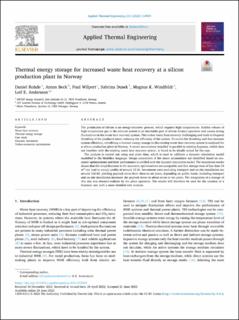| dc.contributor.author | Rohde, Daniel | |
| dc.contributor.author | Beck, Anton | |
| dc.contributor.author | Wilpert, Paul | |
| dc.contributor.author | Dusek, Sabrina | |
| dc.contributor.author | Windfeldt, Magnus Kyrre | |
| dc.contributor.author | Andersson, Leif Erik | |
| dc.date.accessioned | 2022-07-21T09:25:34Z | |
| dc.date.available | 2022-07-21T09:25:34Z | |
| dc.date.created | 2022-06-24T09:18:14Z | |
| dc.date.issued | 2022 | |
| dc.identifier.issn | 1359-4311 | |
| dc.identifier.uri | https://hdl.handle.net/11250/3007481 | |
| dc.description.abstract | The production of silicon is an energy-intensive process, which requires high temperatures. Sudden release of high-temperature gas to the exhaust system is an inevitable part of silicon furnace operation and causes strong fluctuations in the waste heat recovery system. This makes waste heat recovery challenging and leads to frequent throttling of the produced steam reducing the efficiency of the system. To avoid this throttling and thus increase system efficiency, retrofitting a thermal energy storage to the existing waste heat recovery system is analyzed for a silicon production plant in Norway. A steam accumulator installed in parallel to existing bypasses, which does not interfere with the existing waste heat recovery system, is found to be ideally suited for the case. The analysis is carried out using real plant data, which is used to calibrate a dynamic simulation model modelled in the Modelica language. Design parameters of the steam accumulator are identified based on economic optimizations and their performance is verified with the dynamic simulation model. The simulation results shows that the simplifications in the economic optimizations are acceptable and that storage sizes of less than 10 m3 can lead to annual profits of around 23 k€. Investment costs excluding transport and on-site installation are around 120 k€, yielding payback times from three to six years, depending on public funds. Including transport and on-site installation the payback times increase to about seven to ten years. The integration of a storage of this size was deemed realistic by the plant operators. The results will therefore be used for the creation of a business case with a more detailed cost analysis. | en_US |
| dc.description.abstract | Thermal energy storage for increased waste heat recovery at a silicon production plant in Norway | en_US |
| dc.language.iso | eng | en_US |
| dc.publisher | Elsevier | en_US |
| dc.rights | Navngivelse 4.0 Internasjonal | * |
| dc.rights.uri | http://creativecommons.org/licenses/by/4.0/deed.no | * |
| dc.title | Thermal energy storage for increased waste heat recovery at a silicon production plant in Norway | en_US |
| dc.title.alternative | Thermal energy storage for increased waste heat recovery at a silicon production plant in Norway | en_US |
| dc.type | Peer reviewed | en_US |
| dc.type | Journal article | en_US |
| dc.description.version | publishedVersion | en_US |
| dc.rights.holder | The Authors | en_US |
| dc.source.volume | 215 | en_US |
| dc.source.journal | Applied Thermal Engineering | en_US |
| dc.identifier.doi | 10.1016/j.applthermaleng.2022.118909 | |
| dc.identifier.cristin | 2034713 | |
| dc.relation.project | Norges forskningsråd: 257632 | en_US |
| dc.source.articlenumber | 118909 | en_US |
| cristin.ispublished | true | |
| cristin.fulltext | original | |
| cristin.qualitycode | 1 | |

